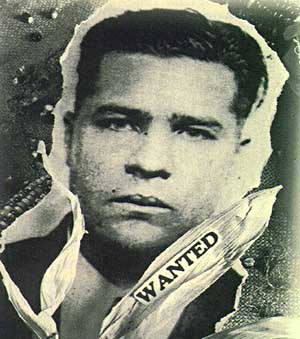Pretty Boy Floyd (Charles Arthur Floyd)

Pretty Boy Floyd
Bank Robber. He was nicknamed “Pretty Boy Floyd” by the press, a name that he personally hated. The name came from his first major robbery, when the robbed paymaster described him as a “pretty boy with apple cheeks” to an interviewing reporter, and the nickname stuck. Born Charles Arthur Floyd in Adairsville, Georgia, he was the fourth child of eight to Walter Lee and Minnie Echols Floyd, a hard working tenant farm couple with deep Southern roots. From an early age, young Charles learned the work ethic of farming; children were expected to join in the hard farm labor almost as soon as they could walk. Raised in the Baptist faith of hard work, Charles did his part in supporting his family. Hearing that good money could be made in the cotton fields of Oklahoma, in 1911, Walter moved his family to the Cookson Hills of Oklahoma, where they settled in the town of Hanson. There, Charles learned to make corn liquor during the Prohibition years of the 1920s, to supplement the family income. Like most of his siblings, Charles completed sixth grade and then dropped out of formal schooling to learn a real trade in farming. It was during his work as a teenaged laborer in the cotton harvest fields of Kansas and Oklahoma that he learned about stealing from lawless robbers who worked part-time as harvest laborers; to young Floyd they represented real life and an easier means of earning a living. In 1921, at the age of 17, Floyd married 16-year-old Ruby Lee “Bobbie” Hardgraves, and they soon had a son, Jack Dempsey Floyd, named for the famous boxer. They would divorce four years later when Floyd was jailed for robbery. Pressed to meet ends for his family, he robbed a US Post Office of $350 in coins, although he was acquitted when a witness failed to appear at his trial. In 1923, at a harvest, he met 19 year old John Hilderbrand, who boasted of robbing a $1900 payroll. From Hilderbrand, Charles learned how to rob stores, service stations, and a Kroger grocery store of $11,500 in payroll cash in St. Louis, Missouri. Quickly caught by police just days later, he was sentenced to five years in prison. Upon his parole in March 1929, he vowed that he would never return to prison again. A fellow paroled con named Alfred “Red” Lovett taught him the art of bank robbing, and introduced him to numerous criminals. Over the next three years, Floyd would reinvent himself into a self-styled robber of the rich, helping the poor by buying groceries for old people, and purchasing Christmas gifts for the poor, all from the proceeds of his thefts. Newspapers soon reported that he was generous to children and old people, and were helping to feed more than a dozen poor families. During this time, he robbed over a dozen banks, but nearly every bank robbery near Oklahoma and neighboring states was attributed to him. Floyd died in October 1934, when FBI agents and local police shot him near East Liverpool, Ohio. Local police and FBI agents were searching for Floyd near south Clarkson, Ohio, when they spotted a car behind a farm corncrib. Floyd emerged from the car, pistol in hand, and the FBI agents opened fire. Hit at least twice, Floyd died about fifteen minutes later. His final moments are in dispute, with one story that the FBI intentionally murdered him while he lay wounded and helpless on the ground, and another story saying that the wounded Floyd pulled out a concealed pistol and was killed before he could shoot at the police. Since his death, Floyd has often been depicted in books and movies as a latter-day Robin Hood, forced by the 1930s social conditions during the Great Depression to hit back at the wealthy, stealing for his family and for other poor families.
Born
- February, 03, 1904
- Adairsville, Georgia
Died
- October, 10, 1934
- East Liverpool, Ohio
Cause of Death
- shot in a corn field
Cemetery
- Akins Cemetery
- Oklahoma

